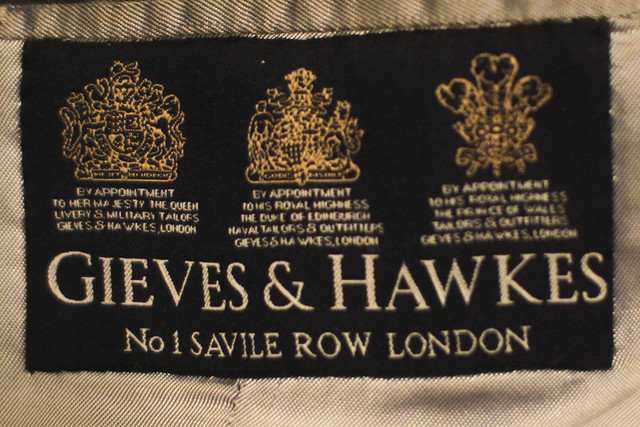
A storm blew through town last night which took down some pretty big trees, and with them, the power. Mine finally came back on this morning but the office is still closed so I glanced over at "the pile"; various garments that have been collecting over the last few months waiting to be chopped up, photographed, and analyzed- maybe today I can dig in a bit and get some blogging done. I've been pretty busy so I'm a bit behind in it, but I realize that I think I'm also running out of interesting things to say; it's getting to the point where there's not so much that's new and interesting to show you- we've seen it all before. (Right at that point I got a message notification about a comment from a reader which read "NEW POSTS PLEASE!!!" Talk about timing)
Well, one things we haven't seen, and which people have asked for several times, is an image of one of the dissection victims on a form or a body, to get an idea of the cut or silhouette. Until now the dimensions of most of the garments were such that I wouldn't have been able to, even if I wanted, and I have to caution that it's not a good idea to put a garment which was cut for one specific body onto another because you don't get an accurate picture, but this one was cut for someone very close to my build, though quite a bit taller than I, judging by the sleeve length. So, for a change, we can have a look at the cut of a garment.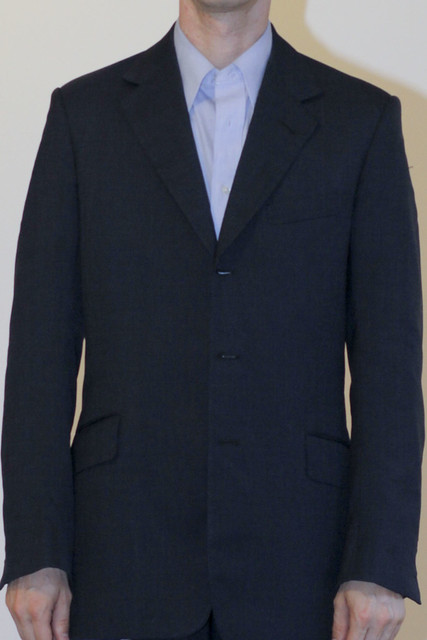
It's a proper 3-button garment with a decent amount of waist and a bit of flare to the skirt. The chest feels fairly firm, but this is not surprising as G&H have a history of military tailoring.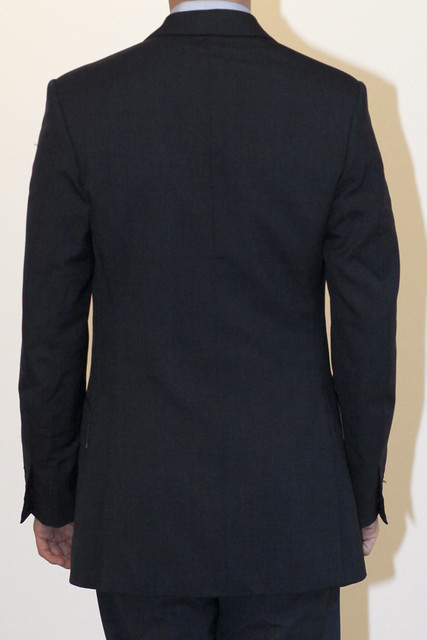
I had heard that G&H use blindstitch machines to pad their lapels so I expected to see that; instead, they were done by hand. There is a liberal sprinkling of fusible in various parts of the garments, but nothing we haven't seen already on other garments from Savile Row so I won't go over them again.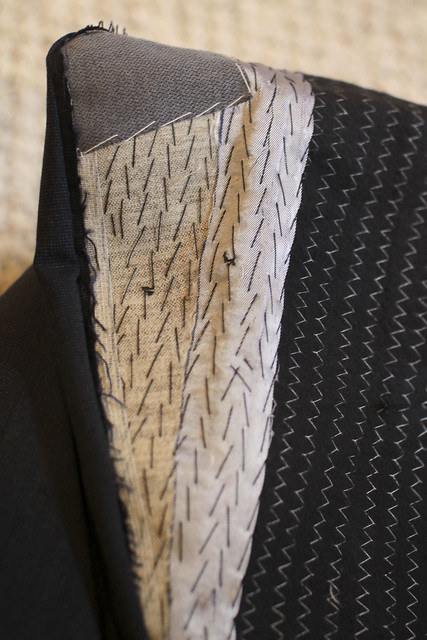
What was a bit surprising was that the chest was padded by zig-zag machine, in a similar fashion to the Saint Andrews garment I cut up, but with a smaller, tighter stitch, which is what gives the firmness to the chest. It would take too long to unpick the whole thing to show you what's inside, but I did just enough to know that the entire chest (the size of the felt) is one big piece of haircloth, with another smaller one in the shoulder. Again, no surprises there.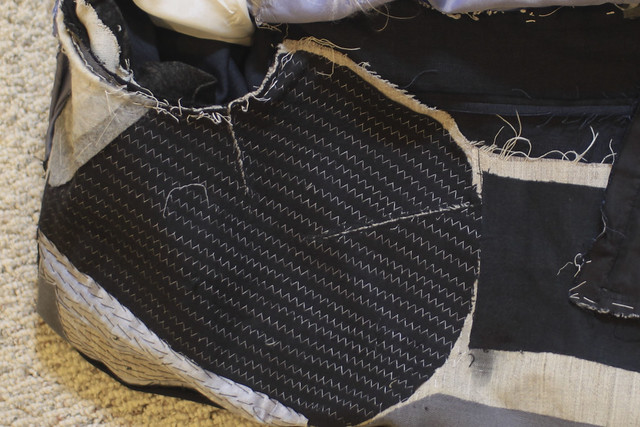
Another thing I found interesting was that the seam joining the side body to the front is shoved way back, making a very narrow side body. This probably makes the shaping of the waist easier- I will have to try it out. I don't know if you can make the seams out in the photo, but FWIW,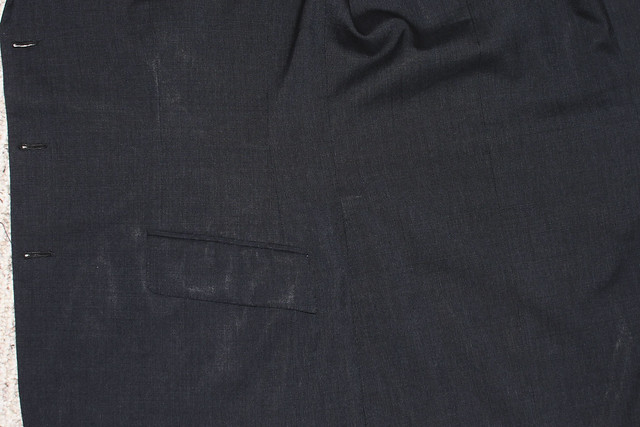
As for the rest, it's all stuff that we would expect to see, and have seen, on other Savile Row garments (newer readers are invited to peruse the archives), so I will blame my writer's block on the clothing.
I'm sure that's a first.








21 comments:
writer's block or not, your time in cutting up and writing about garments is always appreciated.
how about going over particular parts of a garment in greater detail, such as methods of makeup regarding various collars, or sleeves, hems, pockets, etc. i know you have done this to a degree in the dissections, but as an idea to delve further into the methods of construction.
It would be wonderful if you would take a look at a few other brands that are a bit more mid-level. Perhaps something along the lines of Canali, Corneliani, Zegna mainline, Isaia, or Caruso under its various incarnations.
as well a look at fused construction would be interesting. buying a mass market suit and showing us how the fusible is used and why it fails to function create an equal garment to those you have looked at before.
Hi Jeffery,
I have been reading your blog and admire your work very much. It would be interesting to see what your opinion is on what can be expected from a tailor. After reading your blog and seeing the garments you made, my expectations have become very high. If you could provide a checklist of things to look out for before, during and after going to a tailor, for patterned and solid fabric, that would be very helpful and greatly appreciated. Thank you and keep up the great blogging.
Hi Jeffery!
Whatever you decide to write about, I love it!
Thanks for taking the time.
I have seen garments that are padstitched only behind the lapels and others that are padstitched behind the lapels and part of the chest, which gets covered by the lapels. Is there any major difference in this? Does it affect the roll of the lapel despite having the same weight haircloth?
Also, what is the benefit of the padstitch? Why not running stitch, or zigzag behind the lapels of everything?
Thanks for posting again. Does it have a cutters initials on the inside? is it dated at all? thanks!
Thanks, Jeffery! Is it my imagination, or are the pockets placed differently on the right and on the left?
Any suggestions on Montreal area tailor suppliers? Thanks
@s.- a good idea but one that requires a lot of work. Maybe I'll save that for a magazine article or a book, where I will have people to help with things like photography and illustrations.
@Anonymous- there is an article here about canvas and fusing that will answer many of your questions, I think. As for more mid-level garments, it's getting dangerously close to my day job and could create certain conflicts so I really shouldn't.
@yves- thank you, another interesting idea to think about.
@Kim- hi, glad to see you're still around.
@Christopher- I'm not sure I understand your question correctly- maybe you could shoot me a photo or something via email?
@brendan- it's dated November 2002 and I think the cutter was P. O'Neill.
@Max- I had already taken the buttons off so the coat is sitting unevenly on me- a product of setting the timer on the camera and running back to my spot before it goes off. Shame on me. In Montreal the only retail tailor's supplier left is H. Fischer on Saint Laurent, though how long they will be around is anyone's guess- I know Esther was thinking about selling because she's getting up in age. Tell her I said hi.
hi jeff, thanks for replying, I did met Peter O'niel a him a couple of times at Gieves
You could start ripping some waistcoats and more trousers :D
Thanks, Jeff!
All the best for the summer.
How was the finishing? Was it better or worse than what we've seen from SR so far?
@Benjamin E.- it had been altered and repaired so it's hard to say what the original finishing was like.
It will be sad to see the end come to this project, but in truth that's what it is/was. Like a book or a TV series on a particular area. The blog has a specific approach and it probably wouldn't make sense to try and cover issues that don't relate to the issue of 'made by hand vs machine'.
I won't say I'm glad it's come to a probable end, I really enjoy reading and learning from this blog.
Hi Jeffrey,
Wow....I just stumbled on your website and was pleasantly surprised with what I found. You have brought so many memories back. My father was a tailor and your pictures of how a suit is made is exactly how he used to do it. Thank you so much for keeping this art alive.
I so love your blog and all the helpful information. I will have to link to you about the hangers, I feel the same way. I do my own tailoring for a hobby and to have well made clothing.
www.malkainthecloset.blogspot.com
I must have scrolled too far down to click on Post A Comment as I see that it ended up on the wrong post! Here it is again.
*****************
Hi Jeffrey, I will point my partner to this fabulous new post -- he's learning tailoring on his on from books, youtube, your posts, etc. Meanwhile I promised to ask you this question: re: hand stitching the hair cloth the tailoring book he's got says to "baste through all the layers to the jacket fabric" but he doesn't see how one is supposed to do that without the stitches showing through on the right side of the jacket front. In taking jackets apart were you able to observe how this stitch attaches to the jacket? I'm assuming it's got to be a very tiny stitch -- tinier than a pick stitch but anyway if you don't mind helping we'd appreciate it. Thank you in advance! And please don't stop posting -- we look forward to your posts :-).
We figured it out. The basting stitches are put in place only to secure the layers stay together as one piece while they're fitted to a curved surface -- then the stitches are removed!
Hi Susan
Sorry for the late reply- I've been away on vacation, but glad that you got it figured out!
J
Nice men's suits i hope there's a lot more photos from your collection.
Post a Comment